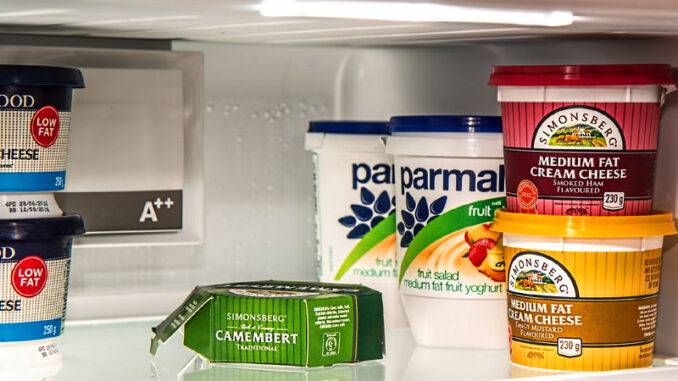
The short answer is: yes, of course, Kefir can (and sometimes even should) be stored in the fridge.
But, regarding temperatures for both storage and fermentation of Kefir, there’s much more to be said, so let’s dig a bit deeper into this topic.
What are the Kefir grains?
The Kefir grains are gelatinous colonies of microorganisms that grow together in symbiosis.
They resemble small cauliflower florets and are clusters of microorganisms held together by a matrix of polysaccharides. The principal polysaccharide is a water-soluble substance called Kefiran. Kefiran is produced by several Lactobacillus species, including Lactobacillus kefiranofaciens and Lactobacillus kefir. They are an integral part of the grain, and without their presence, Kefir grains cannot develop and propagate.
As we said, Kefir grains are colonies of living microorganisms, and just like any other living creature, they are highly dependent on the ambient temperature.
A typical characteristic of Kefir grains is their gelatinous and mucous look and feel due to the presence of Kefiran. This mucous part of Kefir colonies creates ideal conditions in the digestive tract and not only facilitates its colonization but also acts as a protective layer of probiotic bacteria enabling them to successfully get through the harsh stomach acids and reach their final destination – the intestines. Kefiran also makes Kefir grains more resistant to low temperature by acting as “antifreeze.”
What is the effect of temperatures on Kefir?
The effect ambient temperatures have on Kefir is the same as the one they have on all living creatures: High temperatures tend to speed up all life processes up to a certain level, and then, above this level, they start to affect life negatively and ultimately kill. On the opposite, low temperatures tend to slow down all life processes up to a complete standstill called anabiosis.
Low temperatures, however, can also kill because the cells that form all living creatures usually contain water, and when frozen, water forms solid ice crystals that destroy the cell walls and kill the cell altogether.
The same principles apply to Kefir and Kefir grains.
What are the best temperatures for Kefir?
As a mesophilic culture, Kefir grains thrive in moderate ambient temperatures. They develop and propagate best at temperatures between 18 and 28° C (65 and 82° F).
The higher the temperatures are, the faster Kefir ferments and the stronger and tangier it gets. However, the Kefir microorganisms will deteriorate and ultimately die at temperatures above 40° C (104° F).
This is why, while it is always recommended to boil any unpasteurized milk for making Kefir, it is essential to wait until the milk cools down to temperatures way below 40° C (104° F) before mixing it with the Kefir grains.
In the opposite direction, lower temperatures tend to slow down all metabolic processes in Kefir (like in any other living creature).
Low temperatures are, however, unlikely to kill the living bacteria of Kefir. Low temperatures are dangerous to us humans because our bodies contain a lot of water that freezes and forms ice crystals destroying the cell walls. As we already said, Kefir grains are held together by a mucous substance called Kefiran, acting as a sort of “antifreeze.”
Nevertheless, even if low temperatures may not destroy the living colonies of Kefir, they may slow down all life processes in Kefir grains up to a point where they may completely stop. Additionally, water molecules in the environment surrounding the Kefir grains may still be a thread for their life at very low temperatures.
So, while keeping your Kefir grains in the fridge cannot harm them in any way, putting them into the freezer should be addressed with caution (pls. see below).
It is always recommended that the secondary fermentation of Kefir be carried out in the refrigerator.
Sometimes it is a good idea to put Kefir into the fridge even for its primary fermentation. In this case, the initial fermentation may take longer (24 to 48 hours instead of 12 to 24 hours), but as they say, Kefir then becomes smoother, more homogenous, and with fewer curds. Fully fermenting Kefir in the fridge is recommended during really hot summer days when fermentation is faster and Kefir may start to over-ferment after just 5 or 6 hours.
For longer periods of storage, it is always recommended to keep Kefir in the fridge. The low temperatures in the fridge will slow down all metabolic processes in Kefir grains, and they will need less food to stay alive.
Kefir grains feed on the lactose in milk, and without a constant supply of fresh milk, they could starve. So, it is essential to periodically provide them with food by changing the milk in which they are immersed. Depending on the volume of Kefir grains, this milk change must happen on average once a week.
For a storage period of up to two weeks, it is usually sufficient to just immerse the grains in a higher quantity of milk which would prevent them from starving.
For longer periods of storage, however (several weeks or months), it is recommended to either change the milk every week or two, or freeze the grains.
Why is it dangerous to freeze the Kefir grains?
This is a question that our readers ask very often because the answers they get are often controversial.
Many Kefir lovers and addicts are used to freezing their Kefir grains when they need to store them for longer periods. This method works most of the time, and Kefir grains appear to be perfectly healthy after being frozen for months.
Here is the most plausible reason: as we said earlier, the main polysaccharide of Kefir grains is called Kefiran. It is known to form viscoelastic gels that can sustain low temperatures without freezing. This jelly-like mucous substance, holding together the Kefir grains, is most probably the agent acting as “antifreeze” and not allowing the Kefir grains to freeze.
So, presumably because of Kefiran, the Kefir colonies do not appear to be afraid of low temperatures and can support them without major damage.
However, the Kefir grains are usually surrounded by a liquid containing mostly milk, but also a lot of water. When left into a freezer that maintains low temperatures like -18° C (-4° F) or below, the water in this liquid deeply freezes forming large ice crystals that may destroy the cell walls of Kefir grains from the outside, and thus deteriorate them.
So, if you plan to store your kefir grain by freezing them, make sure to dry them out as much as possible before putting them into the freezer. While frost could not directly kill your Kefir grains, the frozen crystals of the surrounding water most probably could.
How to freeze Kefir grains the right way?
- Strain the Kefir grains out of any liquid.
- Carefully let them dry for a couple of days at room temperature, wrapped in clean gauze, cheesecloth, or paper towel.
- Put the Kefir grains into a zip-lock plastic bag, sprinkle them with a little powdered milk, and safely store them in the freezer for months or even years.



